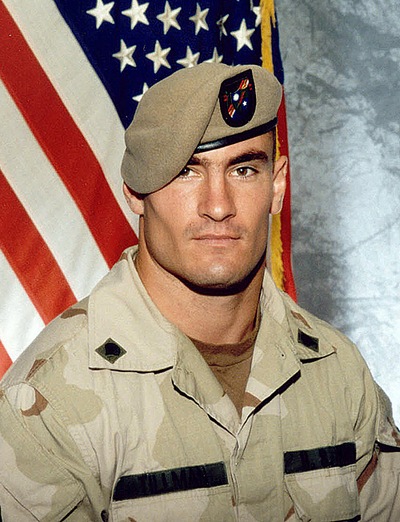Pat Tillman (Pat Tillman)

Tillman was born on November 6, 1976, in Fremont, California. The eldest of three sons, with Kevin and Richard as the other two, Tillman excelled at football. He went to Bret Harte Middle School and helped lead Leland High School to the Central Coast Division I Football Championship. Tillman then went to Arizona State University on a football scholarship.
Tillman was very close to his family and high school friends. He repeatedly mentioned in his personal journals during wartime service that he drew strength from and deeply valued his closest friendships, parents, wife and family. Tillman was very committed to his high-school sweetheart whom he married just prior to enlistment in the Army Rangers, Marie Ugenti Tillman. He also was very close with his brother, Kevin Tillman, who enlisted with and served alongside him.
He started his college career as a linebacker for Arizona State University in 1994, when he secured the last remaining scholarship for the team. Tillman excelled as a linebacker at Arizona State, despite being relatively small for the position at five-feet eleven-inches (1.80 m) tall. As a junior, he helped his team go undefeated that season as well as helping them make it to the Rose Bowl that year. In 1997, he was voted the Pac-10 Defensive Player of the Year. Academically, Tillman majored in marketing and graduated in three and a half years with a 3.85 GPA. He also earned many academic awards including: the Clyde B. Smith Academic Award in 1996 and 1997; the Sporting News Honda Scholar-Athlete of the Year in 1997; and the 1998 Sun Angel Student Athlete of Year. He was inducted into the College Football Hall of Fame in 2010.
In the 1998 National Football League Draft, Tillman was selected as the 226th pick by the Arizona Cardinals. Tillman moved over to play the safety position in the NFL and started ten of sixteen games in his rookie season. At one point in his NFL career, Tillman turned down a five-year, $9 million contract offer from the St. Louis Rams out of loyalty to the Cardinals. Sports Illustrated football writer Paul Zimmerman (Dr. Z) named Tillman to his 2000 NFL All-Pro team after Tillman finished with 155 tackles (120 solo), 1.5 sacks, 2 forced fumbles, 2 fumble recoveries, 9 pass deflections and 1 interception for 30 yards.
Tillman finished his career with totals of 238 tackles, 2.5 sacks, 3 interceptions for 37 yards, 3 forced fumbles, 12 pass deflections, and 3 fumble recoveries in 60 career games. In addition he also had 1 rush attempt for 4 yards and returned 3 kickoffs for 33 yards. In May 2002, eight months after the September 11 attacks and after completing the fifteen remaining games of the 2001 season which followed the attacks (at a salary of$512,000 per year), Tillman turned down a contract offer of $3.6 million over three years from the Cardinals to enlist in the U.S. Army.
Tillman and his brother Kevin enlisted on 31 May 2002. Kevin gave up the chance of a career in professional baseball as he had already signed to play for the Cleveland Indians. In September 2002, they completed basic training together The two brothers completed the Ranger Assessment and Selection Program in late 2002 and were assigned to the 2nd Ranger Battalion in Fort Lewis, Washington. Tillman resided in University Place with his wife before being deployed to Iraq. After participating in the initial invasion of Operation Iraqi Freedom, in September 2003, he entered Ranger School at Fort Benning, Georgia, and graduated on November 28, 2003.
Tillman was subsequently redeployed to Afghanistan. On April 22, 2004, he was initially reported to have been killed by enemy combatants. An Afghan Militia Forces allied soldier was also killed in the action. Tillman’s platoon leader first lieutenant David Uthlaut and his radio telephone operator (RTO), 19-year old Jade Lane, were wounded in the incident. The Army initially claimed that Tillman and his unit were attacked in an apparent ambush on a road outside of the village of Sperah about 25 miles (40 km) southwest of Khost, near the Pakistan border. It wasn’t until after his burial that investigations by the Department of Defense and US Congress were launched, eventually ruling his death as friendly fire.
The Army Special Operations Command initially claimed that there was an exchange with hostile forces. After a lengthy investigation conducted by Brigadier General Gary M. Jones, the U.S. Department of Defense concluded that both the Afghan militia soldier’s and Pat Tillman’s deaths were due to friendly fire aggravated by the intensity of the firefight.
An investigation by the U.S. Army Criminal Investigation Command (CID) concluded that Tillman and the Afghan militia soldier were killed by friendly fire when one allied group fired upon another in confusion after nearby gunfire was mistakenly believed to be from enemy combatants. The CID Report summary, dated 19 March 2007, stated that: “during their movement through the canyon road, Serial 2 [Tillman’s platoon had to split up because of a broken Humvee; the parts were called Serial 1 and 2] was ambushed and became engaged in a running gun battle with enemy combatants. Serial 1 [Tillman’s portion of the platoon] had just passed through the same canyon without incident and were approximately one kilometer ahead of Serial 2. Upon hearing explosions, gunfire, and sporadic radio communication from Serial 2, Serial 1 dismounted their vehicles and moved on foot, to a more advantageous position to provide overwatch and fire support for Serial 2’s movement out of the ambush.” Upon exiting the gorge, and despite attempts by Serial 1 to signal a “friendly position,” occupants of the lead vehicle of Serial 2 opened fire on Tillman’s position, where he was fatally shot.
Born
- November, 06, 1976
- USA
- Fremont, California
Died
- April, 22, 2004
- Spera, Khost Province, Afghanistan
Other
- Cremated, Ashes scattered at sea.



